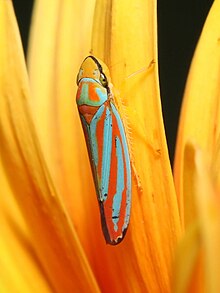en
names in breadcrumbs


Graphocephala coccinea is a meadow and woodland-dwelling species of brightly colored leafhopper native to North and Central America, from Canada south to Panama.[1] Common names include candy-striped leafhopper, red-banded leafhopper, scarlet-and-green leafhopper and red-and-blue leafhopper.
Adults measure 6.7–8.4 mm in length and have vivid blue (or green) and red (or orange-red) stripes on their wings and the top of their thorax combined with bright yellow coloration on their head, legs, abdomen, and elsewhere.
Leafhoppers feed on plant sap with the aid of specialized mouthparts.
G. coccinea has been identified as one of several leafhopper species that is a vector in leaf scorch caused by the gammaproteobacteria Xylella fastidiosa ("Pierce's disease"). X. fastidiosa is responsible for the decline of certain woody plants such as elm, oak, and other ornamental trees.[2] According to a research entomologist at the United States National Arboretum, "An understanding of the transmission of this bacterium by insect vectors is economically important because there is neither any known effective therapy for infected trees and shrubs nor a strategy for preventing infection."[3] In California they damage valuable crops[4] and in Germany they are a nuisance to people sitting under trees in public parks.[5]
At least three subspecies of G. coccinea have been named: G. coccinea confluenta, G. coccinea punctata, and G. coccinea sambuci (all Olsen 1918).[1]
Graphocephala coccinea is a meadow and woodland-dwelling species of brightly colored leafhopper native to North and Central America, from Canada south to Panama. Common names include candy-striped leafhopper, red-banded leafhopper, scarlet-and-green leafhopper and red-and-blue leafhopper.
Adults measure 6.7–8.4 mm in length and have vivid blue (or green) and red (or orange-red) stripes on their wings and the top of their thorax combined with bright yellow coloration on their head, legs, abdomen, and elsewhere.
Leafhoppers feed on plant sap with the aid of specialized mouthparts.
 Candy-striped Leafhopper - Overland Park, Kansas, USA
Candy-striped Leafhopper - Overland Park, Kansas, USA
Graphocephala coccinea is een halfvleugelig insect uit de familie dwergcicaden (Cicadellidae). De wetenschappelijke naam van de soort is voor het eerst geldig gepubliceerd in 1771 door Forster.
Het insect is makkelijk te herkennen aan de knalblauwe basiskleur en felrode tot oranje strepen in de lengte die een driehoek-patroon hebben.
Ondanks zijn geringe lengte kan Graphocephala coccinea al vliegend grote afstanden afleggen.
De cicade komt voor in Noord- en Midden-Amerika. De cicade leeft in grassen en zuigt plantensappen, en wordt zowel in graslanden als in tuinen aangetroffen, de soort is algemeen.
Bronnen, noten en/of referentiesGraphocephala coccinea is een halfvleugelig insect uit de familie dwergcicaden (Cicadellidae). De wetenschappelijke naam van de soort is voor het eerst geldig gepubliceerd in 1771 door Forster.
Graphocephala coccinea (лат.) — вид цикадок из подсемейства Cicadellinae (Cicadellini). Северная Америка (Канада, США, Мексика), Центральная Америка (Панама, Коста-Рика, Никарагуа) [1].
Мелкие насекомые, длина 6—8 мм. Надкрылья имеют яркую окраску из чередующихся синих и оранжевых полос. Голова и ноги жёлтые. Питаются соками растений. Вид был описан в 1771 году немецким энтомологом Иоганном Рейнгольдом Форстером (Johann Reinhold Forster)[2]. Служат вектором переноса некоторых бактерий (например, Xylella fastidiosa, вызывающая болезнь растений «Pierce’s disease»), отрицательно влияющих на такие деревья, как вяз, дуб и на различные декоративные растения[3][4].

Graphocephala coccinea (лат.) — вид цикадок из подсемейства Cicadellinae (Cicadellini). Северная Америка (Канада, США, Мексика), Центральная Америка (Панама, Коста-Рика, Никарагуа) .